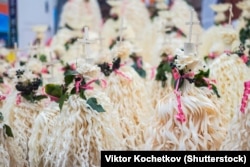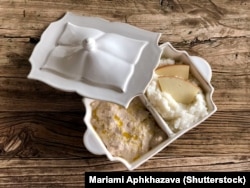As part of an occasional series on how the end-of-year holidays are celebrated in some parts of our broadcast region, we talked to Okropir Rukhadze from RFE/RL’s Georgian Service about how Christmas is celebrated in his country. As a festival with deep roots in Georgia, it is marked by some distinctive age-old traditions and a seasonal feast that showcases the depth and variety of the local cuisine.
As Georgians converted to Christianity in the fourth century, it’s perhaps not surprising that many deep-rooted Christmas customs evolved there over time. Some of them are still going strong today, despite being suppressed during decades of “atheist” Soviet rule.
One of the most quintessentially Georgian traditions, which has enjoyed a revival in recent years, is the “chichilaki” (ჩიჩილიკი). Sometimes described as the “world’s oldest Christmas tree,” it’s something Georgians have been making since ancient times.
“Georgians have their own Christmas tree; it’s very unique,” says Okropir Rukhadze from RFE/RL’s Georgian Service. “Even the Georgian president has asked UNESCO for it be put on humanity’s cultural heritage list.”
Originating in the west of the country, it is now popular everywhere in Georgia, including in the capital, Tbilisi, where “everyone loves it and likes it,” says Rukhadze, describing the annual production of chichilaki as “something very traditional.”
To make chichilaki, Rukhadze says, Georgians “pick a branch of hazelnut — or walnut, but hazelnut is better — and shave it to produce something that looks like a small coniferous tree.”
“When you shave the branch in this way, it becomes white and as long as a hair — this is chichilaki,” says Rukhadze, adding that practically all Georgian households have these “trees” during the Christmas period, usually decorated with fruits, berries, flowers, and sweets, as well as religious symbols such as crosses and angels.
They are traditionally burned on the feast of the Epiphany, which marks the end of Orthodox Christmas celebrations. This is seen as a symbolic way of purging all the trials and tribulations of the past year by letting them go up in flames.
Another ancient tradition banned by the Soviets that has since made a big comeback in recent decades is the “Alilo” (ალილო) procession.
Similar to the custom of singing carols in Western countries, Alilo originally involved groups of men going around their villages the night before Christmas, singing festive songs and collecting alms for the poor in baskets.
The name is thought to have derived from the ancient Hebrew “hallelujah,” meaning praise to the Lord, but Rukhadze says it may have even older origins, as it is similar to a Georgian word meaning “sunrise” — alioni (ალიონი) — which ties in with the belief that many Christmas traditions have appropriated aspects of older, pagan winter solstice festivals aimed at celebrating the sun overcoming the darkness.
Interestingly, the Georgian word for Christmas is “shoba” (შობა), meaning “birth,” which can be interpreted as both a reference to Christ’s Nativity and the advent of the new light as the days get longer.
These days, one of the main Alilo events is a massive parade held on Christmas morning in Tbilisi, which has become a mainstay of the season’s celebrations.
“It’s a huge thing in the capital,” says Rukhadze. “Half of the city is there and everybody — big and small – goes to it, and they collect some food and drink, which they later give to people who don’t have it.”
It’s a colorful event, with participants wearing national costumes or dressed as religious figures or characters from the Nativity story. With the Orthodox Church widening its influence since the fall of communism, Alilo has adopted increasingly religious overtones in recent years, although Rukhadze says there has always been a less pious side to the tradition, with many songs often containing funny lyrics and somewhat worldly jokes, something that is frowned upon by people of a religious bent.
“People think differently about it,” he says. “Some people say it is a light genre of music and some of them think, no, it’s more about angels, about the coming Christ, and it’s very, very serious.”
Being mostly Orthodox Christians, Georgians celebrate Christmas according to the Julian calendar, which means it falls on January 7. With New Year’s happening a week before, they don’t get much time to recover between the festivities.
“Georgians live in a crazy nonsense situation,” says Rukhadze. “They celebrate New Year and drink, and shoot, and eat everything. And then comes Christmas. It is a bit not normal, if you ask me.”
Joking aside, the midwinter festivities in Georgia are not for anyone who likes to do things in moderation, and the country’s traditional Christmas fare offers an array of epicurean delights.
According to Rukhadze, one item that “has to be on the table” at this time of year is “gozinaki” (გოზინაყი), a caramelized sweet that Georgians snack on throughout the festive period.
“These are walnuts fried in honey,” says Rukhadze. “You bring honey to boiling temperature and then add very small, cut-up walnuts. You fry them a bit, too, and then you mix it and flatten it out. You wait until it cools and then you cut it up.”
Rukhadze says most households don’t spare themselves when it comes to making this sweet nougat and can use as much as 2 kilos of nuts to ensure that there’s enough to go around. “You make it for everybody,” says Rukhadze. “To every neighbor it goes, and it’s given to everybody who comes to visit.”
“As fat as a New Year pig” is a common term in Georgia to describe someone of imposing girth, and it’s a phrase that has its origins in the age-old tradition of fattening a hog especially for end-of-the-year festivities. The practice is rooted in the pre-Christmas fast that requires Orthodox Christians to refrain from eating meat until Christmas Day, although this is no longer observed by many.
Nonetheless, pigs continue to be fattened in some regions, and pork dishes are served on January 7.
“They give this pig a special food, you know. So it becomes big and nice and beautiful,” says Rukhadze, although he adds that modern sensibilities mean that a lot of households no longer have a baked pig’s head as the centerpiece of their seasonal table.
“It’s not an aesthetic thing,” says Okropir with a laugh.
Nowadays, Georgians are more likely to symbolically break the Christmas fast with grilled pork flavored with local herbs, but there are also a variety of other dishes that are common at this time of year, including Gurian Christmas pie (საშობაო ღვეზელი), which is a bread similar to khachapuri (ხაჭაპური) but with hard-boiled eggs instead of the usual cheese filling.
“In different parts of Georgia, they have different kinds of food that they do,” says Rukhadze. “Maybe the most popular thing that everybody knows is turkey ‘satsivi’ (საცივი).”
“[It has a] walnut sauce, but it is different from other walnut sauces…. It is a cold dish. The turkey is in a cold sauce and served cold.”
The name satsivi actually derives from the word “tsivi” (ცივი) — Georgian for cold — and it’s a popular sauce that is used with poultry, seafood, and vegetables throughout the year.
At Christmastime, however, turkey satsivi is the preferred dish and is typically served with “ghomi” (ღომი), a traditional hot corn-flour porridge that is often mixed with cheese.
Like many meals at this time of the year, satsivi is not something that is knocked together quickly but usually involves about three to four hours of pretty intensive work.
The time and effort are well worth it, though, as it results in a delicious walnut sauce with spices and flavorings that showcase the unique qualities of Georgian cuisine. It’s even reputed to have been the favorite dish of Josef Stalin, who was Georgian, but don’t let that put you off trying it!
How To Make Satsivi
Ingredients
1 1/2 kilograms (about 3 1/2 pounds) of turkey (or a whole chicken weighing roughly the same)
700 grams (about 6 cups) of walnuts
5 medium-sized onions
4 cloves of garlic
2 tablespoons of white-wine vinegar
1 teaspoon of dried coriander
1 heaped teaspoon of crushed red pepper
1 teaspoon of ground blue fenugreek*
1 heaping teaspoon of dried marigold*
½ teaspoon of cinnamon
5 crushed cloves
Salt
* Blue fenugreek and marigold are native to Georgia and are important ingredients in many local dishes. They may be difficult items to source in many other places, but it is worth the effort to try and track them down as they have very distinctive tastes. Failing that, some cooks suggest using saffron as a substitute for marigold and adding fenugreek seeds instead of blue fenugreek (with six crushed seeds being roughly equivalent to 1 ground teaspoon of the Georgian spice.
Method
- Put the turkey (or chicken) in a pot and add 2 liters of hot water. Leave it on the heat until the meat is parboiled. Remove the turkey and — using the surface oil from the pot water for basting — roast it in the oven at 180 degrees Celsius until it’s cooked. Then cut the meat into thick pieces. Keep the water from the pot as it will be used as a stock later.
- Finely chop the onions and fry until soft, using more of the oil from the pot. Then mix them into a paste in a blender and add them to the leftover pot water.
- Finely grind the walnuts and add the coriander, marigold, fenugreek, cinnamon, and cloves. (If the grinding produces some walnut oil, you can keep it to sprinkle as a garnish over the dish when it’s ready.)
- Blend the crushed red pepper, garlic, and salt by grinding them in a mortar and pestle before adding to the walnut mix with the vinegar.
- Add the pot water to this mixture, stirring constantly until it achieves a smooth, paste-like consistency.
- Using a sieve to remove any unwanted detritus, pour the mixture into the pot used to parboil the meat and add the pieces of turkey. Bring it to the boil and then remove from the heat. Let the dish cool completely before serving.
As a good starting point for learning more about Georgian cuisine, Okropir Rukhadze recommends The Georgian Feast by Darra Goldstein and Savoring Georgia by Rusudan Gorgiladze .
Written by Coilin O’Connor based on an interview with Okropir Rukhadze from RFE/RL’s Georgian Service
Radio Free | Radio Free (2021-01-03T05:00:32+00:00) Holiday Greetings From Georgia, Home Of The 'World's Oldest Christmas Tree'. Retrieved from https://www.radiofree.org/2021/01/03/holiday-greetings-from-georgia-home-of-the-worlds-oldest-christmas-tree/
Please log in to upload a file.
There are no updates yet.
Click the Upload button above to add an update.





